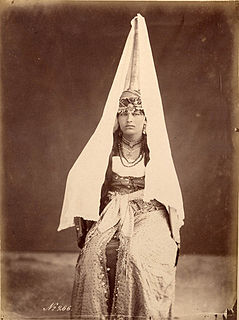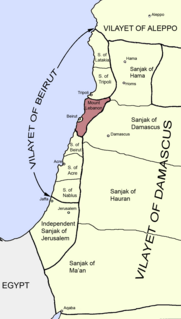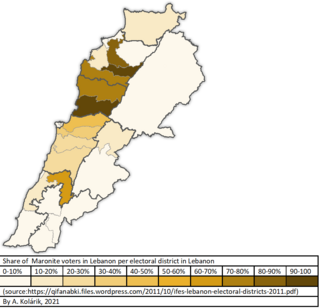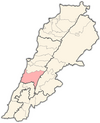
Druze are members of an Arabic-speaking esoteric ethnoreligious group originating in Western Asia. They practice Druzism, an Abrahamic, monotheistic, syncretic, and ethnic religion based on the teachings of Hamza ibn Ali ibn Ahmad and the sixth Fatimid caliph, al-Hakim bi-Amr Allah, and ancient Greek philosophers like Plato, Aristotle, Pythagoras, and Zeno of Citium. Adherents of the Druze religion are called The People of Monotheism (Al-Muwaḥḥidūn).

Mount Lebanon is a mountain range in Lebanon. It averages above 2,500 m (8,200 ft) in elevation, with its peak at 3,088 m (10,131 ft).

Chouf is a historic region of Lebanon, as well as an administrative district in the governorate (muhafazat) of Mount Lebanon.

Bteghrine is a municipality in the Matn District of the Mount Lebanon Governorate of Lebanon.

Baabda District, sometimes spelled B'abda, is a district (qadaa) of Mount Lebanon Governorate, Lebanon, to the south and east of the Lebanon's capital Beirut. The region is also popularly known as "Southern Matn District", as distinct from ْNorthern Matn District,. The capital of Baabda District is the city of Baabda.

Haret Hreik is a mixed Shia and Maronite Christian municipality, in the Dahieh suburbs, south of Beirut, Lebanon. It is part of the Baabda District. Once an agricultural village, Haret Hreik lost its rural identity due to the wave of refugees from Southern Lebanon who settled in the town and made it another urban neighborhood of Dahieh.
Chiyah is situated in the west region of the Lebanese capital of Beirut and is part of Greater Beirut.
Lebanese Americans are Americans of Lebanese descent. This includes both those who are native to the United States of America, as well as immigrants from Lebanon.

Lebanon is an eastern Mediterranean country that has the most religiously diverse society within the Middle East, comprising 18 recognized religious sects. The primary religions are Islam with 60% of the citizens and Christianity with 35% of the citizens. The Druze are about 5% of the citizens. Outside of Lebanon, Lebanese people are mostly Christians. It is also estimated that a large proportion of its population are refugees which affects statistics. The refugees, mostly Syrian or Palestinian, are predominantly Sunni but also includes Christians and Shia.

The 1860 civil conflict in Mount Lebanon and Damascus was a civil conflict in Mount Lebanon during Ottoman rule in 1860–1861 fought mainly between the local Druze and Christians. Following decisive Druze victories and massacres against the Christians, the conflict spilled over into other parts of Ottoman Syria, particularly Damascus, where thousands of Christian residents were killed by Muslim and Druze militiamen. The fighting precipitated a French-led international military intervention.

Lebanese Druze are Lebanese people who are Druze. The Druze faith is a monotheistic and Abrahamic religion, and an ethnoreligious esoteric group originating from the Near East who self identify as unitarians.

The Mount Lebanon Mutasarrifate was one of the Ottoman Empire's subdivisions following the Tanzimat reform. After 1861, there existed an autonomous Mount Lebanon with a Christian mutasarrıf, which had been created as a homeland for the Maronites under European diplomatic pressure following the 1860 massacres. The Maronite Catholics and the Druze founded modern Lebanon in the early eighteenth century, through the ruling and social system known as the "Maronite-Druze dualism" in Mount Lebanon Mutasarrifate.
Na'ameh, or Haret en Naameh, is a Lebanese coastal town located in the Chouf District, an administrative division of the Mount Lebanon Governorate. Naameh was the site of protests regarding waste disposal in 2014.
Haret ech Cheikh, is a municipality in the Matn District in the Mount Lebanon Governorate near Bouchriyeh.
Wadi al-Taym, also transliterated as Wadi el-Taym, is a wadi that forms a large fertile valley in Lebanon, in the districts of Rachaya and Hasbaya on the western slopes of Mount Hermon. It adjoins the Beqaa valley running north to south towards the Jordan valley where it meets the northwest corner of Lake Huleh. Watered by the Hasbani river, the low hills of Wadi al-Taym are covered with rows of silver-green olive trees with the population in the area being predominantly Druze and Sunni, with a high number of Christians, mostly Greek Orthodox. Wadi al-Taym is generally considered the "birthplace of the Druze faith".

Islam in Lebanon has a long and continuous history. According to an estimate by the CIA, it is followed by 67.8% of the country's total population. Sunnis make up 31.9%, Shias make up 31.2%, with smaller percentages of Alawites and Ismailis. The Druze community is designated as one of the five Lebanese Muslim communities, even though most Druze do not identify as Muslims, and they do not accept the five pillars of Islam.

Lebanese Maronite Christians are adherents of the Maronite Church in Lebanon, which is the largest Christian denomination in the country. The Maronite Church is an Eastern Catholic Church in full communion with the worldwide Catholic Church.
Qalaat al-Jandal is a Syrian village in the Qatana District of the Rif Dimashq Governorate. According to the Syria Central Bureau of Statistics (CBS), Qalaat al-Jandal had a population of 3,251 in the 2004 census. Its inhabitants are predominantly Druze.













